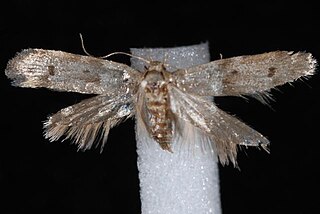Asaphocrita busckiella is a moth in the family Blastobasidae. It is found in North America, including Maryland, Maine, New Brunswick, Ontario, Quebec and Tennessee.
Asaphocrita estriatella is a moth in the family Blastobasidae. It is found in North America, including Nova Scotia, Massachusetts and Maine.
Asaphocrita irenica is a moth in the family Blastobasidae. It is found in North America, from California to British Columbia.
Holcocera anomalella is a moth in the family Blastobasidae. It is found in the United States, including Arizona.
Holcocera coccivorella, the scale-feeding scavenger moth, is a moth in the family Blastobasidae. It is found in North America, including Florida and Maine.
Calosima argyrosplendella is a moth in the family Blastobasidae. It is found in the United States, including Maryland, Pennsylvania, Louisiana, Florida, Maine and West Virginia.
Blastobasis confectella is a moth in the family Blastobasidae. It is found in the United States, including Texas.
Blastobasis floridella is a moth in the family Blastobasidae. It is found in the United States, including Florida and Oklahoma.

Blastobasis pulchella is a moth in the family Blastobasidae. It is found in North America, including Nova Scotia, Washington DC and Maine.
Blastobasis retectella is a moth in the family Blastobasidae. It is found in the United States, including Texas, Florida and Maine.
Hypatopa annulipes is a moth in the family Blastobasidae. It is found in Arizona, United States.
Hypatopa crescentella is a moth in the family Blastobasidae. It is found in North America, including Utah.
Hypatopa funebra is a moth in the family Blastobasidae. It is found in North America, including Pennsylvania, Maryland, Maine and Florida.
Hypatopa hulstella is a moth in the family Blastobasidae. It is found in the United States, including Maine.

Hypatopa simplicella is a moth in the family Blastobasidae. It is found in North America, including Iowa, Pennsylvania, Ontario, Nova Scotia, British Columbia, Quebec, Maine and Oklahoma.
Hypatopa titanella is a moth in the family Blastobasidae. It is found in North America, including Nova Scotia and Maine.
Hypatopa vestaliella is a moth in the family Blastobasidae. It is found in the United States, including Maryland, Massachusetts, Pennsylvania and Maine.
Pigritia laticapitella is a moth in the family Blastobasidae. It is found in the United States, including Texas, Kansas, California, New Jersey, Pennsylvania, Maine, Ohio and South Carolina.
Pigritia murtfeldtella is a moth in the family Blastobasidae. It is found in the United States, including Maine, Ohio, Kentucky, Pennsylvania, Georgia, Missouri, Texas and California.

David Adamski is an American entomologist working as a research associate at the Smithsonian Institution's National Museum of Natural History and a support scientist in the Systematic Entomology Laboratory (SEL), United States Department of Agriculture in Washington, D.C. He obtained a PhD degree from the Mississippi State University, Department of Entomology in 1987 after defending a dissertation, titled "The Morphology and evolution of North American Blastobasidae (Lepidoptera:Gelechioidea)". His research interests focus on alpha taxonomy, life histories and morphology of moths. Over the years, Adamski produced more than 80 scholarly publications, some in collaboration, shedding light on discernible groups of Lepidoptera including Gelechioidea, Tortricoidea, Pyralidoidea, and Noctuoidea. He studied divergent taxa within the Auchenorrhyncha and Sternorrhyncha, and Phytophagous Acari, as well as Gelechioidea and Blastobasidae. Adamski is a member of the Entomological Society of Washington.



